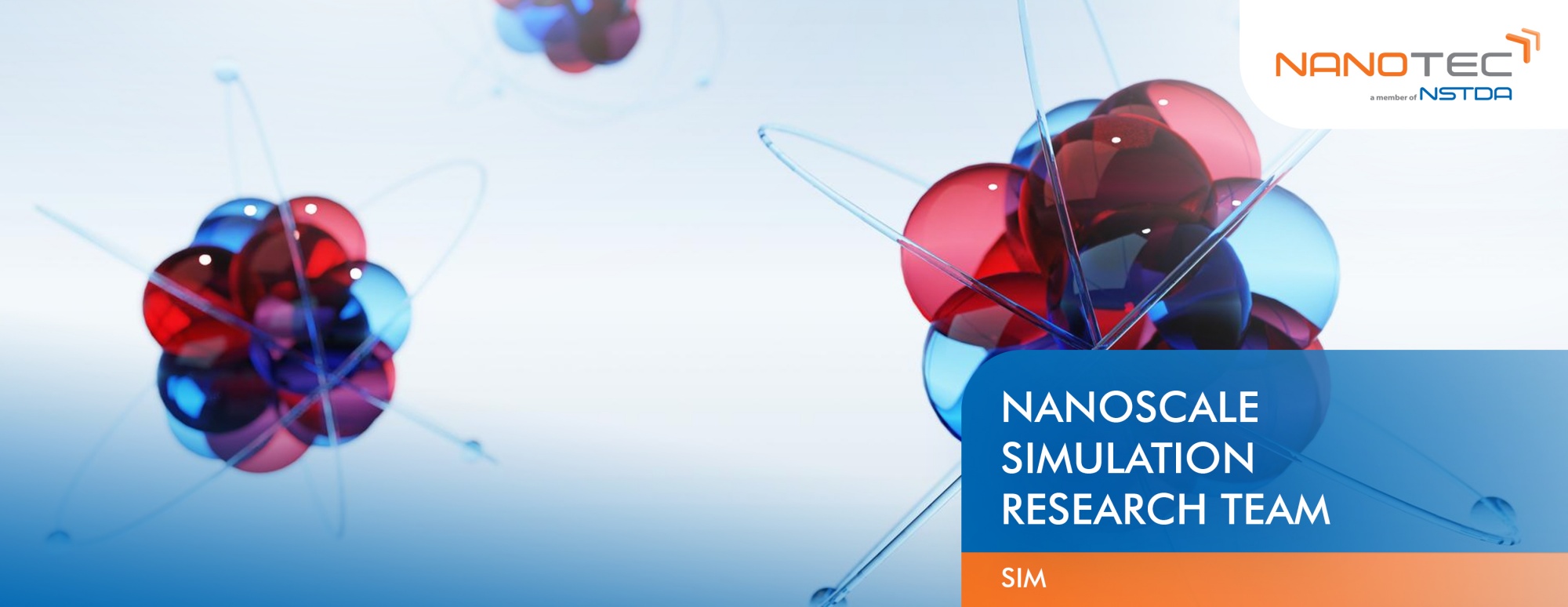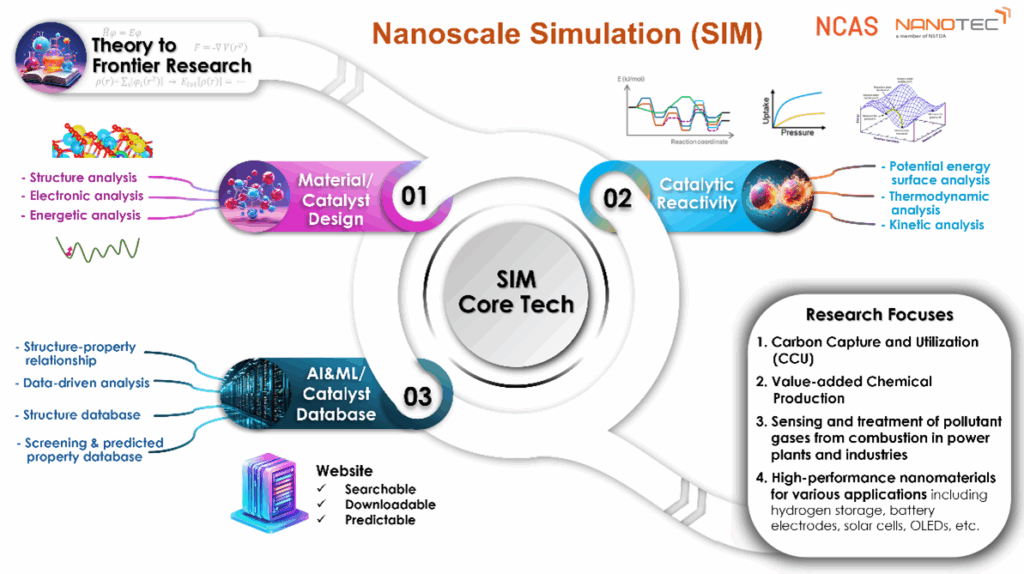
Nanoscale Simulation
The Nanoscale Simulation Research Team (SIM) has extensive expertise in nanoscale modeling and simulation, delivering both foundational scientific insights and practical industrial significance. We focus on designing and predicting the properties of functional nanomaterials, as well as developing a deep understanding of physicochemical processes at the nanoscale. Our expertise spans advanced computational methods—including first principles computational approaches, molecular dynamics, Monte Carlo simulations, microkinetic modeling and machine learning—which enable us to conduct in-depth analyses of molecular interactions, thermodynamics, kinetics, electronic and optical properties. These ‘in silico’ insights provide the fundamental knowledge to accelerate the development of nanotechnology solutions in clean energy, carbon capture and utilization (CCU), and sustainable value-added chemical production—all with a commitment toward achieving carbon neutrality and a sustainable future.

Research Focuses
- Carbon Capture and Utilization (CCU)
- Design and development of porous materials for CO2 capture and storage
- Conversion of carbon dioxide into nanomaterials and value-added chemicals through thermal catalytic reactions, photocatalytic reactions, and electrocatalytic reactions
- Value-added Chemical Production
- Conversion of biomass into biofuels and biochemicals
- Fuel quality improvement
- Sensing and abatement of pollutant gases from combustion in power plants and industries, including heavy metals (e.g., Hg, As), NOx, SOx, and VOCs
- Adsorbents and catalysts
- Sensors
- High-performance nanomaterials for various applications, including hydrogen production, storage, and utilization, as well as battery electrodes, solar cells, OLEDs, and more.
Key Achievements
- CO2 Capture and Utilization (CCU)
- รางวัลวิจัยระดับดี สำนักงานคณะกรรมการวิจัยแห่งชาติ วช 2566 และ 2567
- 2017 L’Oréal-UNESCO For Women in Science Thailand Fellowship
- ACS Appl. Mater. Interfaces. 15 (2023) 12936
- Fuel 319 (2022) 123808
- Mat. Chem. A, 12 (2024) 3084
- Angew Chem. Int. 62 (2023) e202301920
- Am. Chem. Soc. 145 (17) (2023) 9808
- Mat. Chem. A 11 (16) (2023) 9143-9151
- ACS Catalysis 11 (15) (2021) 9688-9701
- Eng. J., 486 (2024) 150248
- Sustainable Value-added Chemical Production
- For Woman in Science (FWIS) award, L’Oréal, Thailand (2022)
- Nanoscale, 16 (2024) 678-690
- Catal., 434 (2024) 115531
- Am. Chem. Soc. 146 (2024) 27528
- Commun., 169 (2022) 106468
- New J. Chem., 45 (46) (2021) 21543
- Green Chem., 22 (2022) 8572
- ChemSusChem, 2022, 15, e202102653
- Surf. Sci. 574 (2022) 151577
- Surf. Sci. 547 (2021) 149170
- Abatement of Exhaust Gases from Electric Power Plants and Industries
- Wiley-CST for Green Chemistry Award 2017
- 2016 L’Oréal-UNESCO For Women in Science Thailand Fellowship
- Surf. Sci. 508 (2020) 145255
- Eng. J. 369 (2019) 124-133
- Sci. Technol. 7 (2018) 356-365
- Catal. A: Gen. 557 (2018) 79-88
- Surf. Sci. 396 (2017) 1712-1718
- Hazard. Mater. 310 (2016) 253-260.
- Surf. Sci. 362 (2016) 140-145
- Eng. J. 274 (2015) 132-142.
- High-performance nanomaterials for other applications
- ACS Appl. Mater. Interfaces. 13(48) (2021) 57306-57316
- Phys. Chem. Chem. Phys. 20 (2018) 6073
- Phys. Chem. C. 116 (2012) 25653−25663
- Dalton Trans. 43 (2014) 9166-9176
We are kindly welcome to collaborate with industry and research partners seeking to apply ‘in silico’ insights to drive R&D and achieve meaningful results, working together to create practical, sustainable innovations that contribute to a cleaner, more resilient future.
Current Research Projects
- Conversion of post-combustion gas from cement manufacturing to syngas by electrochemical CO2 capture and reduction (PMUC)
- Urea production from flue gas via electrochemical reaction
- Carbon Dioxide Capture and Utilization via Artificial Photosynthesis Routes
- Capturing and converting CO2 into high value substances to support carbon neutrality in the chemical industry Energy and services (Fundamental Fund)
- Advanced studies in the direct thermocatalytic conversion of CO2 to valuable chemicals via a reverse water gas shift (RWGS) route using in situ/operando XAS investigation and DFT calculation (PMUB)
- Development of porous materials with amine functional groups for CO2 capture (Fundamental Fund)
- Development of Cu-based catalyst for electrochemical CO2 reduction to C2 products: combined computational chemistry and electrochemical engineering approach (PMUB)
- Utilization of lignocellulosic biomass (lignin and cellulose) in biorefinery industry: Development of value-added bio-based products to reduce dependency on petroleum and GHG emissions
- Multi-Scale modelling for design of nanomaterials for carbon capture and utilization (Fundamental Fund)
- Development and design of heterogeneous nanocatalysts for 5-hydroxymethylfurfural (HMF) conversion to high value biochemicals (NRCT)
Contract NANOTEC
Anchalee Chankeaw
Email : anchalee@nanotec.or.th Tel : 02-564-7100 ต่อ 6661

